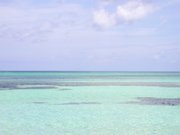By NEIL HARTNELL
Tribune Business Editor
nhartnell@tribunemedia.net
More than one-third of “major” Bahamian hotels will be impacted by just a one metre sea level rise, with a regional study calling for “serious and urgent” action to address the likely climate change impacts on this nation.
The study, published earlier this year by CARIBSAVE, which aims to model the impact climate change will have on Caribbean nations, found that apart from impacting 36 per cent of Bahamian hotels, a one-metre sea level rise would also place 38 per cent of this nation’s airports, and 14 per cent of its road network, at risk.
And, when it came to beach erosion, the CARIBSAVE study found that 70 per cent of key tourism properties would be impacted. On Harbour Island alone, it was estimated that a one metre rise in sea level would cause the “loss of seven high-value tourism properties”.
Detailing the results of its Bahamas coastal surveys, the CARIBSAVE study noted: “Results of these surveys indicate that a one-metre sea level rise places 36 per cent of the major tourism properties at risk, along with 38 per cent of airport lands, 14 per cent of road networks and 90 per cent of seaport lands.
“With a two-metre sea level rise, 50 per cent of major tourism resorts will be impacted. Critical beach assets will be affected much earlier than sea level rise-induced erosion damages to infrastructure. Indeed, once erosion is damaging infrastructure, it means the beach, a vital tourism asset, has essentially disappeared. With 100 metres of erosion, resulting from a one metre sea level rise, 70 per cent of the major tourism resorts will be impacted.”
A two-metre sea level rise, the CARIBSAVE study estimated, would impact 53 per cent of airports and 19 per cent of the Bahamas’ road network. While the economic impact of all this had yet to be determined, the report said an earlier study had estimated the Bahamian tourism industry alone could expect annual losses of between $869 million to $946 million due to sea level rise.
“With 80 per cent of the land lying less than one metre above sea level, all sectors in the Bahamas are highly vulnerable to sea level rise and storm surge,” the report added.
The effects, the CARIBSAVE study said, would be three-fold - a loss of land and its uses; a loss of economic value from existing businesses and communities; and the knock-on effects on other industries such as agriculture.
“The majority of infrastructure and settlements in the Bahamas, like most small island developing states, are located on or near the coast, including government, health, commercial and transportation facilities,” the CARIBSAVE study said.
“The high density tourism development on the coast is particularly vulnerable to climate change and sea level rise, and increases the risk of degradation of coastal and marine biodiversity, thereby reducing its resilience to climate change impacts such as sea level rise and storm surge.”
Looking at Eleuthera and Harbour Island alone, the CARIBSAVE study found that just a 0.5 metre rise in sea level would “innundate” 69 per cent of beaches. And there would also be the “loss of seven high value tourism properties on Harbour Island from the long-term erosion associated with a one-metre sea level rise”.
Analysing the implications of its findings, the CARIBSAVE study said they “reinforce that serious, comprehensive and urgent action that addresses the challenges of adapting to sea level rise is needed in the Bahamas.
“One priority area is to build a full inventory of existing coastal protective defences so that structural protection can be optimised now and into the future, for example, existing seawalls that are in disrepair do not serve their anticipated erosion protection purpose..........
“The Bahamas needs a policy for coastal protection and environmental buffer zones, including an official environmental impact assessment (EIA) mechanism so that Bahamians are protected from storm surge impacts, but also so that future developments are built with an understanding of the projected changes in the coastal zone. The Bahamas Environment, Science and Technology Commission (BEST) has created EIA Guidelines, but they are yet to be enacted.”





Comments
Use the comment form below to begin a discussion about this content.
Sign in to comment
Or login with:
OpenID